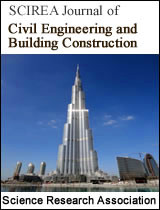Investigation and Study of the Potential Energy and Energy Cost Savings of Ground Source Heat Pump Systems Used in Cold-Climate Regions of the U.S.
DOI: 324 Downloads 15650 Views
Author(s)
Abstract
A Ground Source Heat Pump (GSHP) system has the potential for reducing CO2 emission and fossil fuel consumption. The high heating efficiency of a typical GSHP system compared to conventional heating devices, such as gas-fired furnaces or boilers, makes it more attractive in cold-climate regions, e.g., the areas of the northern Great Plains in the U.S. However, many factors determine the performance of GSHP systems, e.g., control strategy, part/full-load efficiency, the age of the system, whether or not regular maintenance services are provided, etc., any of which could have significant impacts on the normal operation of existing GSHP systems and the achievement of expected energy and energy cost savings. Therefore, the objective of this paper is to further investigate and evaluate the potential energy and energy cost savings of existing GSHP systems currently used in cold-climate regions of the U.S., i.e., the areas of the northern Great Plains. After the comprehensive investigations and simulations of eight existing buildings, the results indicate that the energy savings of these investigated buildings range from 8% to 46% compared to conventional HVAC (Heating, Ventilation, and Air Conditioning) systems. The corresponding energy cost savings, however, is relatively low (with a range between -12% and 42%), due to the extremely low natural gas price in these regions. Additionally, the result of a linear regression analysis indicates that a higher site EUI (Energy Use Intensity) may result in lower energy savings for buildings equiped with GSHP systems and located in these regions.
Keywords
Ground source heat pump, GSHP, Building energy savings, Building energy cost savings, EUI, Cold climate
Cite this paper
Yao Yu, Rui Miao, Zhi Zhuang,
Investigation and Study of the Potential Energy and Energy Cost Savings of Ground Source Heat Pump Systems Used in Cold-Climate Regions of the U.S.
, SCIREA Journal of Civil Engineering and Building Construction .
Volume 4, Issue 1, February 2019 | PP. 1-24.
References
| [ 1 ] | ASHRAE. 2002. Guideline 14-2002, Measurement of Energy and Demand Savings. American Society of Heating, Ventilating, and Air Conditioning Engineers, Atlanta, Georgia. |
| [ 2 ] | ASHRAE. 2007. ANSI/ASHRAE Standard 90.1 – 2007, Energy Standard for Buildings Except Low-Rise Residential Buildings. Atlanta: ASHRAE. |
| [ 3 ] | ASHRAE. 2015. Chapter 34, Geothermal energy. In ASHRAE Handbook – HVAC Applications. Atlanta: ASHRAE. |
| [ 4 ] | Bakirci, K. 2010. Evaluation of the performance of a ground-source heat-pump system with series GHE (ground heat exchanger) in the cold climate region. Energy, 35(7):3088-3096. |
| [ 5 ] | Bakirci, K., Ozyurt, O., Comakli, K., and Comakli, O. 2011. Energy analysis of a solar-ground source heat pump system with vertical closed-loop for heating applications. Energy, 36(5):3224-3232. |
| [ 6 ] | Egg J, Cunniff G, Orio CD (2013) Modern Geothermal HVAC – Engineering and Control Applications. McGraw-Hill Education. Printed in the United States of America. |
| [ 7 ] | EIA. 2017. https://www.eia.gov/dnav/ng/ng_pri_sum_dcu_SND_a.htm for natural gas and https://www.eia.gov/electricity/monthly/epm_table_grapher.cfm?t=epmt_5_6_a for electricity (accessed: May 29th, 2017). |
| [ 8 ] | Flaga-Maryanczyk, A., Schnotale, J., Radon, J., and Was, K. 2014. Experimental measurements and CFD simulation of a ground source heat exchanger operating at a cold climate for a passive house ventilation system. Energy and Buildings, 68:562-570. |
| [ 9 ] | Grandstrand, T., Barse, K., and Schaefer, J. 2011. Preliminary Analysis of Large-scale Geothermal Installation at the University of North Dakota. |
| [ 10 ] | Healy, P.F., and Ugursal, V.I. 1997. Performance and economic feasibility of ground source heat pumps in cold climate. International Journal of Energy Research, 21(10):857-870. |
| [ 11 ] | IGSHPA. 2016. GLHEPRO. Version 5.0. International Ground Source Heat Pump Association. |
| [ 12 ] | Kavanaugh, S., and Rafferty, K. 2014. Geothermal Heating and Cooling Design of Ground-source Heat Pump Systems. Atlanta: ASHRAE. |
| [ 13 ] | LEED. 2009. https://www.usgbc.org/credits/core-shell-new-construction/v2009/eap2 (accessed: Aug. 23rd, 2017) |
| [ 14 ] | Lorraine, A.M. 2007. Geothermal Energy: Another Alternative. DMR Newsletter. 34(1):1-6. |
| [ 15 ] | Ozgener, O. 2010. Use of solar assisted geothermal heat pump and small wind turbine systems for heating agricultural and residential buildings. Energy, 35(1):262-268. |
| [ 16 ] | Ozgener, O., and Hepbasli, A. 2005. Performance analysis of a solar-assisted ground-source heat pump system for greenhouse heating: an experimental study. Building and Environment, 40(8):1040-1050. |
| [ 17 ] | Ozyurt, O., and Ekinci, D.A. 2011. Experimental study of vertical ground-source heat pump performance evaluation for cold climate in Turkey. Applied Energy, 88(4):1257-1265. |
| [ 18 ] | Star, E., 2014. US Energy Use Intensity by Property Type. Retrieved, 15, p.2016. |
| [ 19 ] | Trane. 2015. Trane Trace 700. Version 6.3.2.2.S. Trane, Inc. |
| [ 20 ] | Goetzler, W., Zogg, R., Lisle, H. and Burgos, J., 2009. Ground-Source Heat Pumps. Overview of Market Status, Barriers to Adoption, and Options for Overcoming Barriers. Navigant Consulting, Inc., Chicago, IL (United States). |

